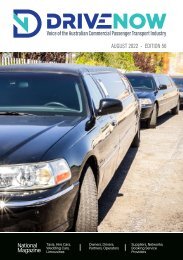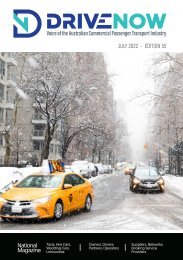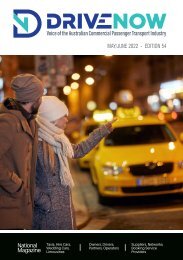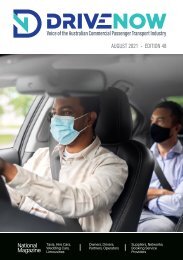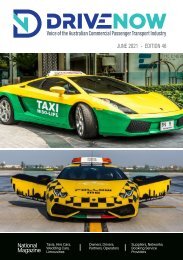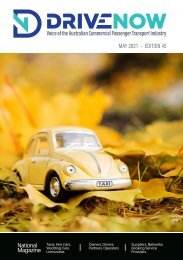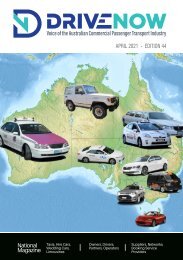DRIVE NOW October/November 2021
*** SCROLL DOWN TO SELECT ALTERNATIVE MAGAZINE EDITIONS *** Australia's only Magazine for the Commercial Passenger Transport Industry. News and views for Drivers, Owners and Operators of Taxi, Hire Car, Limousine, Ride Share, Booked Hire Vehicles, Rank and Hail Cars.
*** SCROLL DOWN TO SELECT ALTERNATIVE MAGAZINE EDITIONS ***
Australia's only Magazine for the Commercial Passenger Transport Industry. News and views for Drivers, Owners and Operators of Taxi, Hire Car, Limousine, Ride Share, Booked Hire Vehicles, Rank and Hail Cars.
- No tags were found...
Create successful ePaper yourself
Turn your PDF publications into a flip-book with our unique Google optimized e-Paper software.
Australia must<br />
SPEED UP<br />
the shift to<br />
electric<br />
vehicles<br />
Emissions from road transport<br />
account for 10 per cent of global<br />
emissions – and that number is<br />
rising faster than any other sector,<br />
as highlighted in the latest Global<br />
EV Outlook report.<br />
Developed nations around the<br />
world, including the United<br />
Kingdom and Canada, have already<br />
pledged to phase out sales or<br />
registrations of new internal<br />
combustion engine cars by a certain<br />
date - but Australia has not.<br />
Nowhere near the<br />
finish line<br />
Despite being one of the world’s<br />
leaders in renewable energy<br />
research and innovation, Australia’s<br />
vehicle emission standard is still<br />
based on the European Emission<br />
Standard five, which is now over<br />
a decade old. More than 80 per<br />
cent of the global car market now<br />
follows 'Euro Six' vehicle emission<br />
standards, including Europe, the<br />
United States, Japan, Korea, China,<br />
India and Mexico.<br />
Beyond the failure to reduce<br />
regional air pollution, Australian<br />
standards have also fallen behind<br />
in mandating fuel efficiency and<br />
hence lower greenhouse emissions.<br />
Cleaner and more fuel-efficient<br />
internal combustion engine cars<br />
can assist in reducing both local<br />
air pollution and greenhouse gas<br />
emissions.<br />
So how can Australia commit to<br />
zero-emission vehicle goals if it’s<br />
behind on global vehicle emission<br />
standards?<br />
Associate Professor Iain<br />
MacGill, Joint Director of UNSW<br />
Collaboration on Energy and<br />
Environmental Markets, says<br />
Australia hasn’t made a serious<br />
effort to address transport-related<br />
emissions.<br />
“The transport sector is one of<br />
the continuing growth areas of<br />
Australia's emissions profile,” he<br />
says.<br />
“However, we’ve seen so many<br />
petrol-fuelled sports utility vehicles<br />
and twin cab utes being purchased<br />
that it seems likely that the average<br />
fuel efficiency of Australian cars is<br />
going backwards.”<br />
Chicken and egg<br />
debate<br />
The pathway to zero-emission<br />
transport almost certainly requires<br />
electric vehicles fuelled by zeroemission<br />
electricity. Last year, less<br />
than one per cent of new cars<br />
bought in Australia were EVs. That<br />
compares with more than four per<br />
cent globally, almost six per cent<br />
in China and nearly 75 per cent in<br />
Norway.<br />
18 <strong>October</strong>/<strong>November</strong> <strong>2021</strong>






